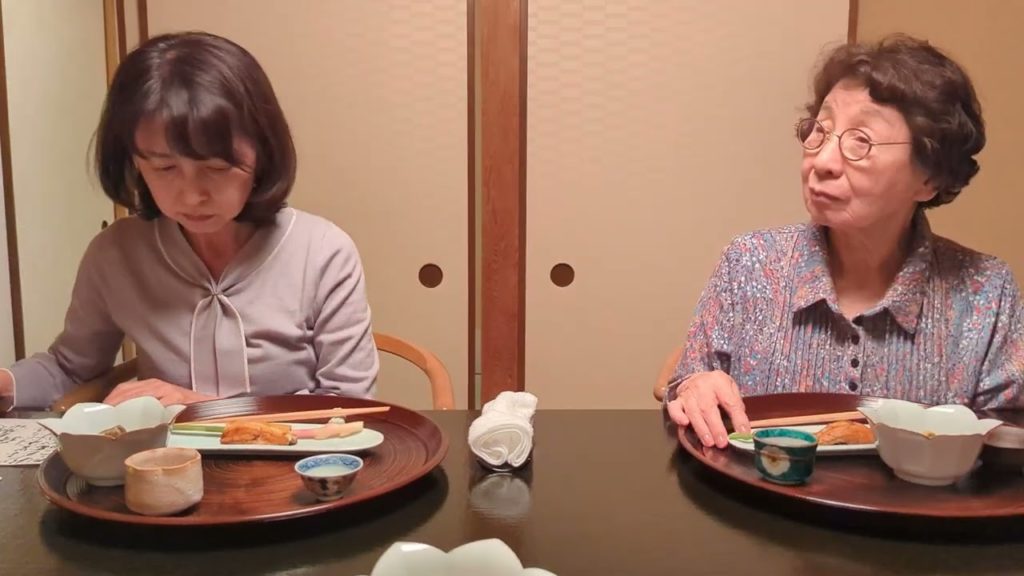We enjoyed a wonderful Japanese Kaiseki dinner in our Doudan (満天星) suite room during our stay at Asaba Ryokan (あさば), located in Shuzenji (修善寺) in the Izu Peninsula in Shizuoka Prefecture, Japan. The explanation of each serving was in Japanese, but I’ve done my best to explain it in English (and Japanese) below:
COURSE 1:
* Soramame to Kobudashi Surinagashi (空豆すり流し – Grated Small Broad beans and Konbu Sea Kelp dashi soup)
COURSE 2:
* Biwa-ko Chiayu Karaage (琵琶湖稚鮎からあげ – Deep-fried Baby Sweetfish from Lake Biwa Karaage)
COURSE 3:
* Suruga-wan Tachiuo Yakishimo Wan (駿河湾太刀魚焼霜椀 – Clear Soup with Cutlass Fish from Suruga Bay that’s been lightly seared with its skin on and then cooled. This method supposedly results in the removal of excess fat and odor, and the original flavor of the fish is enhanced.)
– Shiraga Negi (白髪葱 – Thin, long Green Onion Strips)
COURSE 4:
* Suruga-wan Ise Ebi Yakishimo (駿河湾伊勢海老焼霜 – Ise/Spiny Lobster from Suruga Bay, lightly seared with its shell on)
– Ise Ebi Miso An (伊勢海老味噌庵 – Ankake Sauce made from Ise/Spiny Lobster Tomalley)
– Yura Uni from Suruga-wan (駿河湾由良雲丹 – Yura Red Sea Urchin from Suruga Bay)
– Wasabi (山葵)
– Hanaho Shiso (花穂紫蘇 – Shiso Flowers)
COURSE 5:
* Kagoshima Wagyu Sumibi-yaki (鹿児島和牛炭火焼 – Charcoal-grilled Kagoshima Wagyu Beef)
– Hana Wasabi Shoyu-zuke (花山葵醤油漬け – Wasabi leaves and flower buds flavored with Soy Sauce)
– Soramame (空豆 – Small Broad beans)
FOR HER:
* Amagi Shamo Sumibi-yaki (天城軍鶏炭火焼 – Charcoal-grilled Amagi Shamo Chicken)
COURSE 6:
* Tokobushi to Fuki no Sunomono (トコブシと蕗の酢の物 – Vinegared Tokobushi Abalone and Fuki Butterbur plant stems)
COURSE 7:
* Anago Kuromai Sushi (穴子黒米すし – Conger Eel with Black Rice Nigiri Sushi)
– Shizuoka Ken-san Kuno Shoga (静岡県産久能生姜 – Ginger from Kuno, Shizuoka Prefecture)
COURSE 8:
* Hamamatsu-san Shin Tamanegi Fukume-ni to Shoga Oroshi (浜松産新玉葱含め煮とおろしショウガ – New” (fresh seasonal) Onion from Hamamatsu simmered in a light, soy-based broth with grated Ginger)
COURSE 9:
* Hokkaido Hotate to Suruga-wan Sakura-ebi Koromo-age (北海道帆立と駿河湾桜えび衣揚げ – Hokkaido Scallops & Suruga Bay Sakura Shrimp Tempura)
– Kogomi Koromo-age (こごみ衣揚げ – Ostrich Fern Tempura)
COURSE 10 – GOHAN (御飯 – Rice Dish):
* Mie Ken Kuwana-san Hamaguri to Shuzenji no Seiryumai Takikomi Gohan (三重県桑名産蛤と修善寺の清流米炊き込みご飯 – Shuzenji Seiryumai Steamed Rice with Common Hard Clams from Kuwana in Mie Prefecture)
COURSE 11 – KOUNOMONO (香の物 – Pickled Vegetables):
* Kabu to Aspara Nukazuke (蕪とアスパラ糠漬け – Japanese Turnip and Asparagus “Nukazuke.” Nukazuke is a type of Japanese preserved food, made by fermenting vegetables in rice bran (nuka), developed in the 17th century.))
COURSE 12 – AKADASHI (赤出汁 – Red Miso Soybean Paste Soup):
* Nama Nori Misoshiru (生のり味噌汁 – Red Miso Soybean Paste Soup with Raw Seaweed)
COURSE 13 – KANMI (甘未 – Dessert):
* Blancmange (ブラマンジェ – Blancmange is a sweet French dessert that’s sort of like Panna Cotta – a category of eggless custard desserts)
* Kuzukiri to Kuromitsu (葛切りと黒蜜 – Kuzukiri with Japanese black sugar syrup. Kuzukiri is a transparent noodle made from water and kudzu / Japanese Arrowroot powder)
COURSE 14 – KANMI #2 (甘未 – Dessert #2):
* Yomogi Ice Cream (蓬アイスクリーム – Mugwort Ice Cream)
* Mikan Hana Ice Cream (みかんの花の蜂蜜アイスクリーム – Ice Cream made with the Honey from the flower of Mikan Japanese Citrus)


AloJapan.com